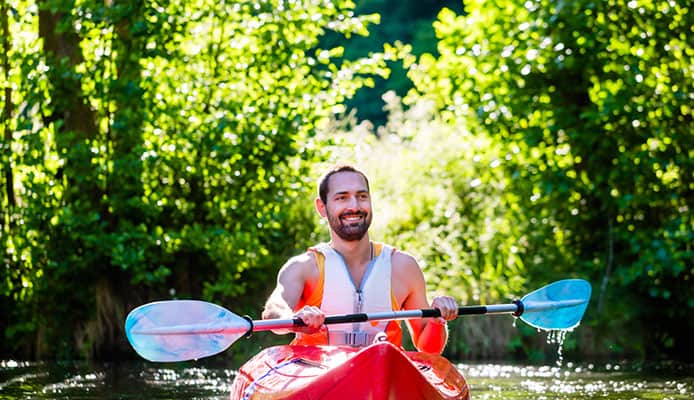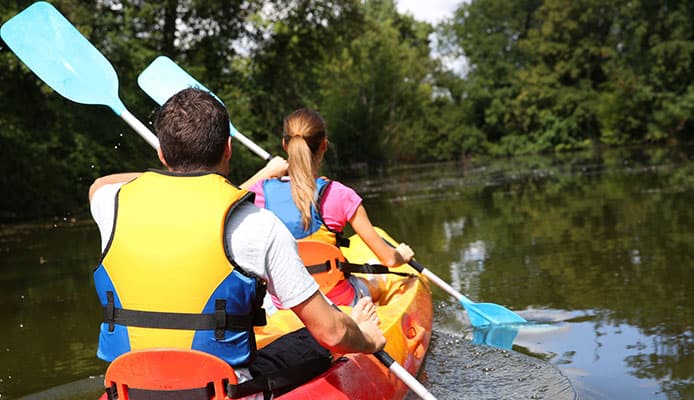
Picture this; you are in a kayak, paddling merrily in an amazing sunny afternoon. You are feeling the breeze from the ocean as sweet birds’ melodies soothe your soul. You are humming your favorite song and thinking to yourself, “This day can’t get any better,” when suddenly a speeding powerboat emerges behind you and the instant wake sends you thrusting into the water.
A kayak capsize is one of the scariest boating experiences. It is even worse if you are paddling in winter because your body can get frozen real quick.
So, this brings us to the purpose of this post – do you know your kayak’s wet exit and entry? Do you know how to do it right and fast? We will look at this deeply in a little bit but first, let’s get ourselves acquainted with the basics.
What Is A Kayak Wet Exit And Entry?
A kayak wet exit is when a kayak tips over and the kayaker has to get out of it while still submerged in water. If you are using a sit-on-top kayak and you happen to flip over, you are just going to fall off and all you got to do is tip it back to an upright position and climb back on. In a sit-in kayak, however, you will have to perform a wet exit.
Knowing how to do a wet exit is essential as it ensures that you get out of your vessel safely. It also gives you the skills to survive situations that send you underwater. Not only that; the fact that you will get used to being submerged in water with your kayak benefits you a lot when it comes to mastering other moves such as an Eskimo roll.
A kayak wet entry or wet entry is simply getting back into your kayak after doing a wet exit. It is a skill that every kayaker needs to practice, as it builds confidence and speeds up their ability to rescue themselves in an emergency flip over the situation.
How To Properly Do A Wet Exit And Entry
Learning how to quickly get back in a kayak after it’s flipped over is important. Hypothermia is real guys and it can immobilize you in a blink. Here is how to properly do a wet exit and entry faster and easier.
But let’s practice first! Zip into your life jacket. Have a paddle float handy. Bring a trusted friend and let’s hit the water.
If you just started learning how to kayak, we would suggest that you begin with calm waters and slowly by slowly, graduate to rougher conditions. Aim at completing the sequence within the least time possible.
The Wet Exit
-
Relax
Even the most experienced kayakers feel uncomfy being submerged in water when they attempt a wet exit for the first time. It is not the best feeling but overcoming it now will help you in your future kayaking adventures.
We suggest intentionally tipping your kayak and hanging upside down inside the water for a couple of seconds. You can have your friend standing next to you for peace of mind or to provide help in case you start to panic.
Take all the time you need to relax. Touch the water. Smile at fish. Trust us, you can stay down there holding your breath for quite long if you only allow your mind to relax and not think about what surrounds you.
2. Remove Your Spray Skirt
If you have a spray skirt, slide your hands toward the front and locate its grab loop. Pull the loop forward and then back in your direction. If you only yank it toward you, the spray skirt will not release. So, forward then backward.
3. Push Out
Put your chin close to the chest and move your body forward. Push off the cockpit rim with your hands so your head doesn’t hit the bottom as you exit. You may not have the time to do this if your flip is unintentional but if you are learning how to do a wet exit, then this is a good place to get started.
Kayaks tend to throw you out when you flip so it is obvious that at this point you are already out of the watercraft. If you are having a hard time pushing out, then you are probably using a kayak that is smaller than you.
4. Hold On To Your Kayak And Paddle
Safety should be your number one priority. Examine your scene to determine if it is safe to do the exit.
Hold on to your kayak paddle because, without it, you won’t be able to get back to the shore. Do not obsess though. Save yourself first and if your paddle slips overboard, just try to retrieve it after you have popped yourself out of the water. Just be sure to take a deep breath before going back underwater.
You might also like: How to Get In and Out of a Kayak?
Quite often, when a kayak is upside down, it tends to suction or seal to the water, making rolling it back up almost impossible. If you are paddling in shallow waters and can stand, getting it back into an upright position will be easy. Just swim or walk to the bow and lift it so it breaks the seal. Then roll it over to an upright position. If your paddle slipped into the water, now would be the best time to retrieve it.
The Wet Entry
Now that you have successfully made a wet exit, it’s time to do a kayak wet entry.
- Put your paddle float onto the paddle and blow air in it if it is inflatable.
- With this end floating on water, place the blade at the back of your kayak seat and perpendicularly to the kayak such that it forms an X between the paddle and the kayak.
- Make sure your weight is distributed evenly between the boat and the paddle and crawl back in. You can try other ways like rolling to get back into your kayak particularly if you have hip injuries, back injuries, or any other injury that could affect your crawling.
- Once you are back up, get rid of any water in the kayak. If you have a bilge pump, this will be a piece of cake. Just start pumping!
- With your boat free of water, you can now continue paddling, with or without the paddle float. Remember you are just learning and the more you practice, the more you perfect your skills.
Globo Surf Overview
Flipping a kayak can be a life-threatening experience especially if you are not used to being underwater. It is therefore important to take enough time to learn and practice kayak wet exit and entry so you can paddle with confidence and be able to get yourself out of danger.
If you practice kayak self-rescue more often, even a wet exit and entry will start feeling all quick and natural and you won’t have trouble saving your life. Just make sure to have some help signaling equipment on board so that in case your rescue mission fails, you can be able to call for help.
More Skils Guides:
- Plastic Kayak Repair Guide
- How To Properly Strap Two Kayaks Into A Car Roof Rack
- How To Roll A Kayak
- How And Where To Sit In A Kayak
- What Muscles Are Used In Kayaking
- How To Easily Tow A Kayak
- How To Do Kayak Edge And Brace Stroke
- How To Paddle A Tandem Kayak
- How to Carry a Kayak: The Right Way!


